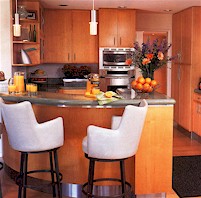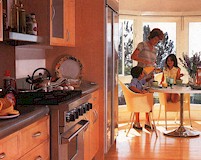|

Kitchen
and Bath Ideas - Fall 2000
Kid-Friendly
Curves
Written by Ann Wilson
Field editor Andrea Caughey
Photographer Ed Golich
 Remodeled
with kids in mind, this thoroughly modern kitchen keeps traffic moving
and stands up to the daily wear and tear of an active family. Remodeled
with kids in mind, this thoroughly modern kitchen keeps traffic moving
and stands up to the daily wear and tear of an active family.
An uninspired layout, a traffic-blocking island, and limited access to
the adjacent family room were just a few of the problems Liz and Charlie
Silver wanted to fix in the kitchen of their La Jolla, home.
The Silvers envisioned a kitchen that invited their children, Jocelyn,
now 8, and Gordon, 6, to stay awhile, yet also allowed the children to
move freely from one area to the next, without passing through the kitchen's
work space. In addition to having the kitchen tyke-accessible, the couple
wanted it outfitted with modern materials that harmonize with the contemporary
sensibilities of their 1970s home.
"The layout was not family-friendly and the surfaces were very dark,"
Liz recalls. "We have ocean views and wanted to keep the house light.
We definitely wanted to have a breakfast bar, where we could have stools
where the kids could sit and interact with me when I was working on the
other side of the counter."
To turn their vision into an efficient and aesthetically pleasing reality,
the Silvers turned to designers Lance Stratton and Laurie Haefele, who
began by throwing a couple of curves into the kitchen to increase its
contemporary appeal and its function.
"We took the island out to open up the space, "Haefele says. "The new
curved peninsula gives flow and movement to the space and makes the breakfast
room, family room, and kitchen flow together. The whole design started
with the curve of the peninsula."
Once the peninsula-which sweeps in an arc, separating the family room
and breakfast nook from the work space-was inked on the plan, the designers
added the storage and surfaces the Silvers desired. An overhang on the
peninsula's outside edge fashions the much-desired breakfast bar-a perfect
fit for vinyl-upholstered stools designed to withstand cereal or soda
spills. Two undermount sinks are positioned at the peninsula's bend, allowing
a look through the breakfast nook windows. A dining room door was closed
off to extend a wall and make space for new range-side countertops and
the existing refrigerator-freezer. Stainless-steel details and clear-finish
maple cabinets that match the room's hardwood floors add up-to-date polish.
Concrete countertops, such as those in the Silvers' kitchen, are poured
on-site into frames atop cabinets. Stands of glass added to the concrete
provide strength and prevent cracking, but there are still likely to be
imperfections and hairline fissures-neither of which affect durability.
 To
bear the weight and contain concrete's inherent wetness, cabinet subtops
require extra support and a few coats of sealer. After the concrete is
poured, finishing is a matter of perfect timing. "[Installers] have to
pull off the form when the concrete is had enough to hold its form, but
still soft enough for the installers to drag a custom-cut wood or metal
template across the edges," designer Lance Stratton says. The concrete
is then hand-finished and sealed. To
bear the weight and contain concrete's inherent wetness, cabinet subtops
require extra support and a few coats of sealer. After the concrete is
poured, finishing is a matter of perfect timing. "[Installers] have to
pull off the form when the concrete is had enough to hold its form, but
still soft enough for the installers to drag a custom-cut wood or metal
template across the edges," designer Lance Stratton says. The concrete
is then hand-finished and sealed.
Easily cleaned with a damp sponge, the countertops should not be used
as a cutting board or to hold hot pots. Although material costs are low,
total materials and labor costs for poured concrete countertops are comparable
to granite countertops.
Maple has overtaken oak as the most popular wood for kitchen cabinetry,
according to the National Kitchen & Bath Association. Although maple is
typically favored for its natural, pale hue, it's suitable for a variety
of stains and paint finishes. In face, staining maple to resemble another,
more expensive hardwood, such as cherry, can be cost-effective. A straight,
close grain and a uniform texture make maple well-suited for long and
tall sections of cabinetry. It resists abrasion and indentation well.
As with all hardwoods, maple can be dusted regularly and cleaned as needed
with water and a mild, nonalkaline soap, such as dishwashing liquid. Cabinets
should be immediately dried and lightly buffed with a soft cloth, following
the direction of the grain.
Slightly more expensive than glass, perforated stainless-steel panels
make suitable replacements for glass or wood cabinet panels. In this kitchen,
they were chosen for several upper-cabinet doors, as well as the doors
that cover the wine rack in the peninsula. Made in a variety of patterns,
perforated metal is readily available at large sheet metal shops, where
it can be cut to specific measurements. Installed in door frames in a
similar manner to glass panes, the metal panels promote air circulation
and function well on cabinets where pantry staples such as onions and
potatoes are stored. The panels should occasionally be coated with lubricating
oil or metal polish; the coating protects the finish from fingerprints
and grease stains.
"The perforated-metal panels on some of the cabinets were included because
we wanted to give some relief to the expanses of wood," Stratton says.
"We already introduced metal in the appliances and as a stainless-steel
toe-kick, which breaks up the maple floors and the maple cabinets." A
trio of metal-mesh halogen fixtures-safely set out of kids' reach above
the sink area-reinforce the peninsula's curve and echo the texture of
the metal cabinet panels.
To warm up the simple-but-sleek spaces, the Silvers chose the earthy imperfections
of poured concrete for the countertops. "We couldn't find a stone material
in the green," Liz says. "I love the concrete countertops."
In fact, she and her family love everything about their new kitchen. They
find it works just as well for impromptu parties as it does for a breakfast
on the run. No matter who's working behind the peninsula, he or she is
always part of the breakfast nook action.
"I like the fact that it's compact enough. Everything is right there and
it doesn't take too many steps," Liz says. "I never feel isolated and
I love the visual look; it's light and cheerful."
|
![]() Copyright © 2016 Dewhurst
& Associates. All rights reserved.
Copyright © 2016 Dewhurst
& Associates. All rights reserved.